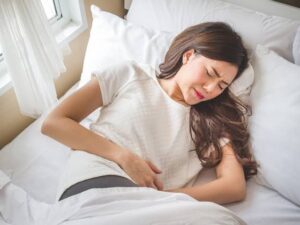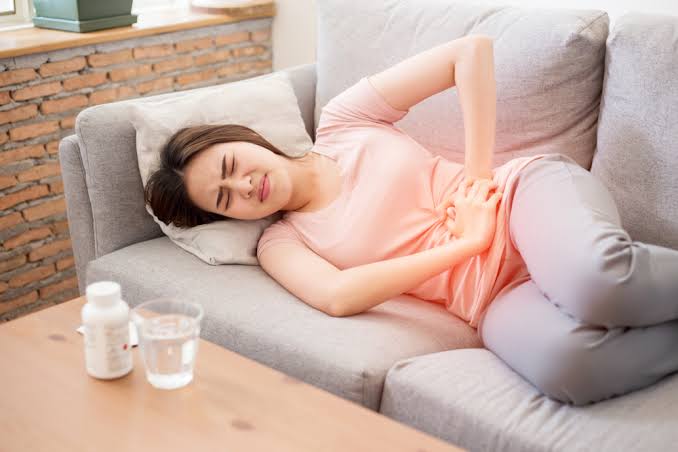Periods are unquestionably unpleasant. Menstruation is frequently accompanied by cramps, bloating, and cravings, and while most women can expect this misery to last no more than a week, some may experience discomfort for a little longer. Dr. Peter Weiss, OB/GYN at Rodeo Drive Women’s Health Clinic, tells Woman’s Day that cramps are normal one or two days after your period. However, cramps that last more than a few days after your period are not normal, so if you’ve been dismissing your cramps as a normal part of your cycle, it’s time to address them.
Because symptoms can mimic other conditions, it’s easy for women to “normalize” their pain or believe it’s all in their head, according to Dr. Rebecca Brightman, OB/GYN and founding member of Eastside Women’s OBGYN Associates. This “normalization” of symptoms, however, can make it more difficult to diagnose a more serious condition. If you have cramps for more than a day or two after your period, here are some reasons why this may be happening, as well as what you can do about it.
What are these cramps known as?
DyDysmenorrheaefers to painful menstrual cramps. There are two types of dysmenorrhea: primary and secondary. Primary dysmenorrhea refers to the common menstrual cramps that occur every cycle a few days before your period and are completely normal for the majority of women. Secondary dysmenorrhea, on the other hand, is more severe than regular menstrual cramps and is frequently caused by a reproductive system disorder or infection.
What does having cramps after my period mean?
Secondary dysmenorrhea occurs when you have pelvic pain that lasts more than one or two days after your menstrual period ends. It’s important to note that secondary dysmenorrhea can occur at any time during your menstrual cycle. Uterine fibroids, ovarian cysts, uterine or endometrial polyps, or pelvic inflammatory disease can all cause cramps after your period and are all treatable. Endometriosis and adenomyosis are two of the more serious causes.
Describe the pain of cramps following your period.
Secondary dysmenorrhea, like its primary counterpart, can be accompanied by several distressing symptoms. These, according to Dr. Brightman, include but are not limited to painful sex, painful bowel movement and urination, pelvic pain, bleeding or spotting between periods, heavy menstrual bleeding, bloating, and difficulty participating in daily activities. But secondary dysmenorrhea rarely causes other symptoms like those listed above.
What factors can contribute to cramping after menstruation ends?
There are three main reasons why women experience cramping in the days following their periods: a growth (like uterine fibroids, ovarian cysts, or uterine or endometrial polyps), an infection (like a pelvic inflammatory disease), or a disorder of the reproductive system (such as endometriosis and adenomyosis).
Period pain, pelvic pain, and sexual pain can all be symptoms of endometriosis, which occurs when tissue that normally lines the inside of your uterus starts growing outside of the uterus. Adenomyosis is caused by the growth of tissue, just like endometriosis. This tissue, which is very similar to the uterine lining, develops into the uterine muscle and is shed during menstruation. An enlarged uterus, or adenomyosis, can cause pain in the pelvic region and very heavy periods. Some of these conditions, like ovarian cysts, have been linked to abnormal growth.
On the other hand, pelvic inflammatory disease (PID) is an infection that spreads from the vagina to the uterus and other pelvic organs due to STIs. While not technically an STD, it is often the result of sexually transmitted infections.
How can I treat cramping after my period?
The treatment of cramping after menstruation is condition specific. Many cysts and polyps don’t need treatment other than regular observation by your healthcare provider, which is good news if the growth is the source of your pelvic pain. However, if the tumor is malignant, won’t go away on its own, or is causing severe symptoms, surgical removal is warranted.
Once you know that PID is the root cause of your cramps, you can start treatment. Antibiotics are effective against PID, as they are against most infections, and you may feel better before the infection has completely cleared up. However, it’s important to take the full course of medication prescribed to eliminate the infection.
Since endometriosis and adenomyosis have no known cause or cure and typically disappear when menopause begins, treatment can be challenging for those who suffer from cramps due to these conditions. Even though there is currently no cure, treatments such as non-steroidal anti-inflammatory drugs (NSAIDs) and hormonal birth control can help slow tissue growth and alleviate painful symptoms. It is possible to remove the endometrial tissue and the uterus (via a hysterectomy) in extreme cases.
When to see your doctor
Any changes or concerns you have about your period symptoms should be discussed with your doctor. Dr. Brightman adds, “if you’re unable to manage your menstrual symptoms with lifestyle changes and find that your symptoms are affecting your health and daily activities, then you should talk to your doctor.”






